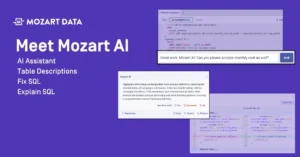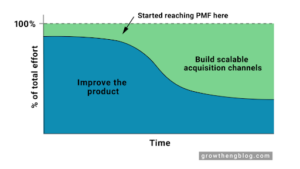One of the growing pains successful companies experience is moving from spreadsheet-based reporting to automated dashboards. It’s a necessity if you want to build an agile business, but the transition can be challenging. That’s because it requires the important step of centralizing all data from your siloed sources inside a data warehouse.
When considering whether Snowflake or BigQuery is right for your business, keep these three considerations top-of-mind:
-
Ensure the solution you choose integrates well with your existing tech stack.
-
Setup should be painless so it doesn’t divert internal resources for longer than necessary.
-
Your new data warehouse must be able to scale with your business.
With these three factors in mind, we’re going to take a closer look at two of the most popular cloud-based data warehouses on the market: Snowflake and BigQuery. We’ll explore their core similarities and differences, as well as their current pricing models.
Similarities and differences between Snowflake and BigQuery
Serverless data warehouses like Snowflake and BigQuery store, process, and compute data in the cloud. This virtual infrastructure means businesses using these solutions don’t need to invest in hardware or physical space to house their data. To secure data and comply with privacy regulations, both of these virtual warehouses maintain encryption when data is at rest and in transit.
In terms of hosting, BigQuery runs on the Google Cloud Platform (GCP), as it’s a Google product. Snowflake can be hosted on AWS, Microsoft Azure, or GCP. (Snowflake is an independent, publicly-traded technology company, which is why it offers the ability to be run on any of the Big Three clouds.)
Snowflake’s data warehouse natively connects to dozens of technology partners across a variety of industries, offering integrations for IT, product development, and marketing. It also has support for semi-structured data, like JSON, and offers interfaces for programmatic access to Python, Node.js, Java, PHP, Go, Microsoft .NET, and C Language.
The breadth of BigQuery’s native technology integrations isn’t as extensive. As such, users may have to rely on Cloud Data Fusion Plugins or the BigQuery Data Transfer Service, both of which may carry extra costs and engineering support. BigQuery offers client libraries in Java, Python, Node.js, C#, Go, Ruby, and PHP. It’s also possible to use Google Apps Script to access BigQuery from Sheets.
Snowflake and BigQuery are both SQL-based, columnar data warehouses with decoupled storage and compute architectures.
Column-based database management systems are organized by fields instead of by record, which is how row-oriented databases are arranged. These two organizational structures are both efficient, but for different reasons. Websites and apps are typically built on a row-oriented database because it’s quicker to write, or append, new information to these records. For example, new profile data that a customer has submitted. Column-based databases are better suited for reporting and querying since all like data are stored next to each other.
Imagine you wanted to find out how many of your customers live in New York City. In a row-based warehouse, you would need to load each row, identify the value, and compute. However, if that information is stored in a column, you would simply query that single column. Faster computations lead to cost savings as well.
Pricing: Snowflake vs BigQuery
Since both offer centralized storage decoupled from computing, they’re able to separate pricing for these two components. This is important because it offers the flexibility for cost savings.
Compute units are where a majority of a company’s data warehouse costs will come from, as storage pricing has steadily declined for decades. At this time, it costs just $20-$25 per month to store one terabyte (TB) of digital data. Many businesses will cap out at one TB of data. Therefore, separating storage from computing enables companies to better control costs because they can allocate varying levels of computing resources to different jobs. BigQuery and Snowflake calculate compute costs differently, though.
BigQuery’s overall pricing structure is complex. At a very high level, their compute fees are broken down by on-demand and flat-rate options, while storage pricing is per gigabyte and broken down by active and long-term data classifications. BigQuery processing is based on the amount of data being computed, so the query time matters less than the number of bytes being worked on. Generally speaking, this results in slightly higher computing costs compared to Snowflake.
Snowflake’s pricing model is more simple. There are just three levels of pricing — standard, enterprise, and business critical — so you pay for the services you need. Storage can be purchased up front or on a month-to-month basis. Snowflake’s compute charges are based on query time, not byte size, so more complex data processing will cost more. In most business use cases, compute, and thus analysis, is cheaper on Snowflake.
Which is better: Snowflake or BigQuery?
At Mozart Data, we strongly believe Snowflake is the clear best-in-class data warehouse, particularly for start-ups and smaller agile companies. Not only is it easy to implement, but also presents great opportunities for cost savings. Additionally, while BigQuery offers many attractive features, most businesses won’t be able to use them to their full potential due to lack of resources or necessity. Snowflake’s system is powerful enough to support small- and medium-sized businesses now and for years into the future as they scale.
Set up your Snowflake warehouse in minutes with Mozart Data
Mozart provides an out-of-the-box modern data stack that’s built with Snowflake under the hood. We chose best-in-class technology to serve our customers and make it easy for them to go from siloed data to analysis-ready in an hour. Because of the scale of our partnership with Snowflake, we’re able to pass cost savings to our customers. By getting your Snowflake data warehouse through Mozart, you’ll save 30% compared to independently purchasing Snowflake and the rest of your data stack. Read more about why we chose Snowflake above others.


